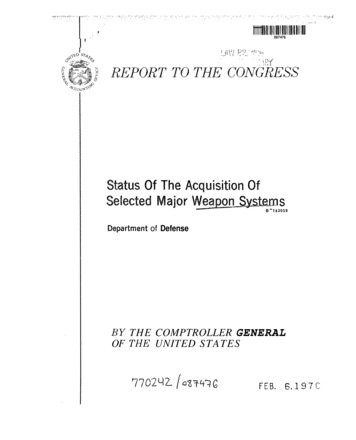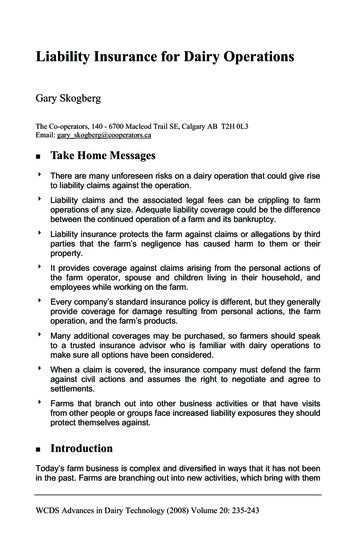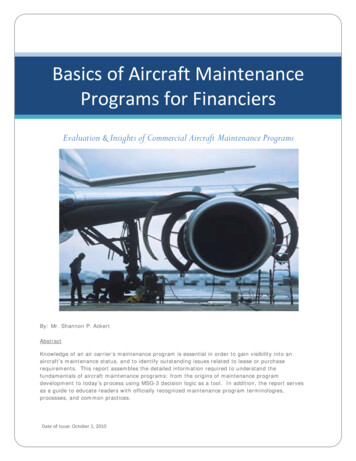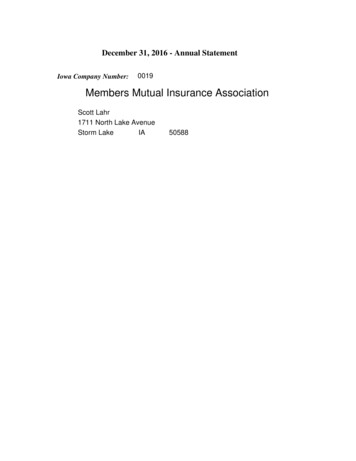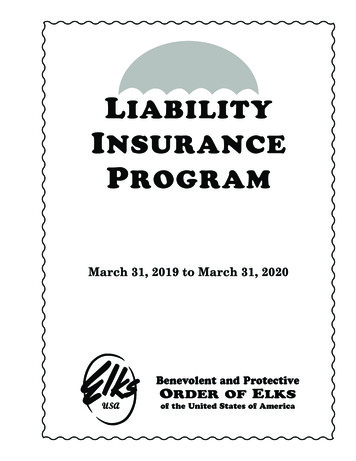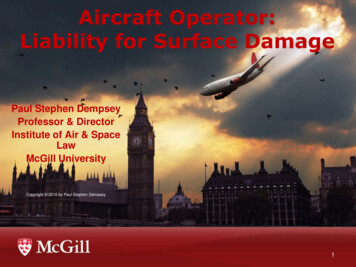
Transcription
Aircraft Operator:Liability for Surface DamagePaul Stephen DempseyProfessor & DirectorInstitute of Air & SpaceLawMcGill UniversityCopyright 2015 by Paul Stephen Dempsey1
2
3
4
5
1960 – collision of UAL DC-8 and TWA Lockheed 1049 over Brooklyn, kills 6 onthe ground and 128 aboard1960 – US military aircraft crashes into Munich, kills 32 on the ground, and 20aboard1992 – El Al cargo aircraft crashes into Amsterdam apartment building kills 39on the ground, and 34 aboard1997 – Russian military aircraft crashes into Irkutsk, killing 452000 – Air France Concorde crashes on takeoff, killing 4 on the ground, and109 aboard2001 – hijacked aircraft crash into World Trade Center and Pentagon killing2,996, including 19 hijackers2007 – TAM Airbus 320 crashes into Sao Paulo houses, kills 12 on the ground,and 187 aboard2007 – Anatov 26 crashes into three houses in Kinshasha, killing 49 on theground2008 – Kalitta Air Boeing 747 crashes into Bogota farm house, killing 26
Early Common LawGuille v. Swan 1822: Hot air balloon landsin a garden in New York City; a crowdtramples the landowner’s vegetables;the operator is held strictly liable.The early common law treated aviation asan ultrahazardous activity, for whichstrict liability was imposed.7
The modern common lawviewToday, commercial aviation has become so ubiquitous and safethat it is considered a matter of “common usage” rather than anultrahazardous or abnormally dangerous activity.Therefore, principals of negligence govern in many jurisdictions.An exception exists for certain types of “abnormal” aviation, suchas stunt flying, experimental aircraft and sonic booms.But some courts apply negligence principles to aircraft-to-aircraftcollisions, and strict liability to ground damage, on principlesthat the aircraft imposes a “non-reciprocal risk” to surfacedamage.Some courts also apply principles of trespass, nuisance andinverse condemnation to surface damage.8
TrespassTrespass constitutes unauthorized interference with the exclusivepossession of land.One trespasses if he enters into the immediate reaches of the air spacenext to the land, and interferes substantially in the landownersenjoyment of land.The aircraft operator is strictly liable if physical harm to land or personsor chattels on the ground is caused by ascent, descent or flight of anaircraft, or dropping or falling of an object therefrom.9
NuisanceNuisance constitutes an unreasonable interference with the quietuse and enjoyment of land.The remedy is rarely an injunction, but where a governmental entity(e.g., airport) is the defendant, the remedy may be inversecondemnation, where the defendant pays damages tocompensate the landowner for his loss on grounds that privateproperty has been converted to a public use.10
Surface damage isoften governed bydomestic lawGermany: the liability for damages caused by an aircraft is limitedaccording to the weight of the aircraft.France and Switzerland: the liability for damage to third parties onthe ground is unlimited.European Union: no common rules exist governing the liability fordamage occurred to third parties on the ground. EU Regulation785/2004 provides minimum insurance requirements not commonliability rules. Among EU States, only Belgium, Italy, Luxembourgand Spain have ratified the Rome Convention 1952.11
United KingdomSection 76(2) of the Civil AviationAct 1982If “material loss or damageis caused to any person orproperty on land or water by,or by a person in, or an articleor person falling from anaircraft while in flight, takingoff or landing damages inrespect of the loss shall berecoverablewithouttheproof of negligence orintention or other cause ofaction, as if the loss ordamage had been caused bythe wilful act, neglect, ordefault of the owner of theaircraft”.12
The Rome Convention of 19331.2.3.4.5.6.7.Strict Liability imposed upon the aircraft operator.Liability offset if the damage caused or contributed to by the claimant.Liability limits set according to the weight of the aircraft.Liability ceiling breached only if aircraft operator engaged in gross negligenceor willful misconduct.Operators required to carry insurance, or a guarantee.The plaintiff could bring suit either in the State of the operator’s residence, orwhere the damage was caused.The 1933 Convention gained only five State ratifications, and the 1938Brussels Protocol, which modernized the Convention, attracted only tworatifications.Convention for the Unification of Certain Rules Relating to Damage Caused by Foreign Aircraft to Third Parties on the Surface (1933 RomeConvention) adopted in Rome on 29 May 1933; Protocol Supplementary to the Convention for the Unification of Certain RulesRelating to Damage Caused by Foreign Aircraft to Third Parties on the Surface (1938 Brussels Protocol), Signed in Rome on 29 May1933, Done at Brussels on 29 September 193813
The Rome Convention of1952Objective: “ensure adequate compensation for persons who suffer damagecaused on the surface by foreign aircraft, while limiting in a reasonablemanner the extent of liabilities incurred for such damage in order not tohinder the development of international civil air transport”.Embraced the principles of the 1933 Convention, but raised liability limits up to 33,000 per person, and 700,000 per occurrence.The Convention applies to damage caused to third parties to damage on theground in the territory of a contracting State by an aircraft registered inanother Contracting State.Today 49 ratifications, the largest (in terms of traffic) being Brazil, Argentina,Russian Federation, Belgium, Italy and the UAE.Australia, Canada and Nigeria ratified, and subsequently renounced theirratification.Convention on Damage Caused by Foreign Aircraft to Third Parties on the Surface (1952 Rome Convention) signed atRome on 7 October 1952; Protocol to Amend the Convention on Damage Caused by Foreign Aircraft to ThirdParties on the Surface, as adopted and signed at Montreal on 23 September 1978 and entered into force on1425July 2002 (The 1978 Protocol) .
The Rome Conventionof 1952The Rome Convention of 1952 governs surface damage by aircraft in flight in anyinstance where “the damage was caused by an aircraft in flight or by any person orthing falling therefrom . . .”.Liability is imposed on the operator (the registered owner is presumed to be theoperator) of the aircraft.Liability is not fault based, but is limited, based upon the weight of the aircraft.The cap for each person killed or injured on the ground is approximately 33,000 andthe total cap per incident being around 700,000, depending on the weight of theaircraft.15
The Rome Convention of 1952 –Exoneration from LiabilityNo person who wrongfully solely caused thedamage is entitled to recover under theConvention, and a claimant who contributesto the damage is subject to the doctrine ofcomparative fault.The operator is exonerated from liability isprovided where “damage is the directconsequence of armed conflict ordisturbance ”.16
The Rome Convention of 1952 –Liability Ceiling PiercedHowever, where harm is intentionally causedby the aircraft operator’s employees, liabilityis not capped.Also, liability is unlimited Unlimited liability isalso incurred for any person who “wrongfullytakes and makes use of an aircraft withoutthe consent of the person entitled to use it”.17
Liability Limited to the Weight ofthe Aircraft(a) 500,000 francs for aircraft weighing 1,000 kgs or less;(b) 500,000 francs plus 400 francs per kilogramme over 1,000 kgs foraircraft weighing more than 1000 but not exceeding 6,000 kgs;(c) 2.5 million francs plus 250 francs per kg over 6000 kgs for aircraftweighing more than 6000 but not exceeding 20,000 kgs;(d) 6 million francs plus 150 francs per kg over 20,000 kgs for aircraftweighing more than 20,000 but not exceeding 50,000 kgs;(e) 10.5 million francs plus 100 francs per kg over 50,000 kgs foraircraft weighing more than 50 000 kgs;The liability in respect of loss of life or personal injury shall notexceed 500,000 francs per person killed or injured.18
Piercing theliability ceilingThe liability limits can be broken if the claimant proves:Damage was caused “by a deliberate act or omission of theoperator, his servants or agents [acting in the course of theiremployment and within the scope of their authority], donewith intent to cause damage”.Unlimited liability may also be imposed on any person who“wrongfully takes and makes use of an aircraft without theconsent of the person entitled to use it”.19
The Montreal Protocolof 1978Raised liability PER PERSONfrom 500,000 (US 33,200) under the Rome ConventionTo 125,000 SDRs (US 185,000) under the Montreal Protocol.Raised liability PER OCCURRENCE from 500,000 – 10,500,000Francs plus 100 Francs per kg for aircraft over 50,000 kg Peraircraft (US 663,000).To 300,000 SDRs – 2,500,000 SDRs plus 65 SDRs per kg over30,000 (US 444,000 to 3,699,000) under the MontrealProtocol.But only 12 States ratified the Montreal Protocol of 1978.20
Early Negotiations Towarda New TreatyIn 2004, the ICAO Council created a Special Group on Modernization of the RomeConvention. Early on, the Council Special Group agreed on several points: Victim protection should at least match that in the 1999 Montreal Convention. Adequate protection for the air transport system, including air carriers, ought to beprovided, and should especially address the problems of “catastrophic losses”. To balance the aforementioned interest, it would be necessary to take account of theavailability of insurance coverage in the market or other mechanisms. It is not possible to reconcile the two goals of providing both adequate victimcompensation and appropriate protection for the civil aviation sector within thepresent scope of the compensation system. A supplementary funding mechanism for compensation could bridge the gapbetween what is an adequate level of victim protection for the civil aviation sectorand ensuring the sustainability of the airline industry.21
The Montreal Conventions of2009:(1) General Risks Convention -The Convention on Compensation forDamage Caused by Aircraft to Third Parties covers liability for thirdparty damages caused by an aircraft on an international flight, butnot arising as a result of unlawful interference. It seeks to replace theRome Convention by providing strict liability for compensation ofvictims.(2) Unlawful Interference Convention - The Convention onCompensation for Damage to Third Parties Resulting from Acts ofUnlawful Interference Involving Aircraft provides compensation toindividuals suffering damages as a result of unlawful interference ofaircraft. It establishes a supplementary compensation mechanismfor damages incurred beyond the limits on liability contained in thenew Convention.22
COMMON ATTRIBUTES OF THE CONVENTIONSBoth Conventions set out to balance the interests of equitablycompensating victims with ensuring the financial viability of the aviationindustry.Both Conventions impose liability upon aircraft operators for damage tothird parties occurring in a State Party by an international aircraft inflight.They allow recovery for mental injuries “resulting either from bodily injuryor from direct exposure to the likelihood of imminent death or bodilyinjury”.As in the Chicago Convention, State aircraft are excluded from the scopeof the Convention.
DamagesLiability limits for the operator range from 750,000 Special Drawing Rights (SDRs)for an aircraft weighing under 500 kilograms, to 700 million SDRs(approximately US 1.1 billion) for an aircraft weighing over 500,000 kilograms,per event.If two operators cause the damage, the limit of liability is determined by theaircraft of the highest maximum mass, and the operators are deemed jointlyand severally liable.Aircraft lessors and financiers that are not operators are excluded from liability.Operators (and under the Unlawful Interference Convention, the InternationalFund) may be exonerated from liability to the extent that they prove thedamage was caused, or contributed to, by an act or omission of a claimant orthe person from whom the claimant derives his rights. Specifically, theConventions limit or exclude liability when the victims committed actscontributing to or causing damage which were “. . . done with intent orrecklessly and with knowledge that damage would probably result . . .”.24
DamagesThe liability ceiling can be pierced under General Risks Convention if the operator fails toprove it was not negligent, or the damage was solely due to the act or omission ofanother.The Unlawful Interference Convention has three tiers of liability:TIER 1. the first is the same as the General Risks Convention (Tiered, strict liabilitydepending upon the weight of the aircraft; maximum of 750,000 SDRs);TIER 2. a compensation fund up to 3 billion SDRs per occurrence funded by levies frompassengers and shippers; andTIER 3. a non-binding obligation of States to compensate.The injured party also may break the ceiling if intentional act of operator, or willfulmisconduct, unless the operator proves it appropriately selected and monitored itsemployee and complied with Annex 17. What?Comparative fault principles apply.Recovery for death, bodily injury, and mental injury (“resulting from bodily injury or fromdirect exposure to the likelihood of imminent death or bodily injury”), and in someStates, environmental damageNo recovery allowed for punitive, exemplary or non-compensatory damages.25
Other Features of the TwoConventionsThe remedy is exclusiveRight of Recourse: against anyone who committed,organized or financed the act; but no recourse is allowedagainst the owner, lessor, financier, or manufacturer.26
PROCEDURAL ISSUESBoth Conventions impose a two-year period of limitations commencing “from the dateof the event which caused the damage”.Venue is limited to the “courts of the State Party in whose territory the damageoccurred”.If damage occurs in more than one State Party, suit may be brought “only before theState Party of the territory of which the aircraft was in or about to leave when theevent occurred”.This centralization of litigation in a single jurisdiction is one of the Conventions'strengths, inasmuch as it will facilitate claims' consolidation and, perhaps,settlement.Also, judgments shall be recognized and enforced in any State Party.
The General Risks Conventioncompensation ceilings may be pierced unless the operatorproves: (1) it was not negligent and did not act wrongfully,or (2) damage was solely due to the act or omission ofanother person.
29
The Unlawful InterferenceConventionThe Convention establishes a three-tier system of compensation for surfacevictims:1. In the first tier, the aircraft operator will pay up to 700 million SDRs (in theaggregate to all claimants), or approximately US 1.1 billion, for which theaircraft operator is required to have “adequate insurance”.2. In the second tier, a new International Civil Aviation Compensation Fund(ICACF) will be established to collect fees from airlines to build a fund up to3 billion SDRs (approximately US 4.8 billion).3. In the third tier, governments are encouraged (but not required) to step inand provide compensation, and under certain circumstances, the aircraftoperator can be forced to pay if the 3.7 billion SDRs (approximately US 6billion) in the first two tiers is exhausted.
Signatures - RatificationsGENERAL RISKS CONVENTION:UNLAWFUL INTERFERENCE CONVENTION: Benin 21/2/2013Benin 21/1/2013Berkina Faso 20/3/2013Cameroon 25/10/2011Congo 1/10/2014Côte d’Ivoire 2/5/2009Ecuador 19/8/2013Ghana 2/5/2009Kuwait 4/7/2014Montenegro 18/7/2012Panama 15/6/2009Serbia 2/5/2009South Africa 30/9/2010Uganda 2/5/2009Zambia 2/5/2009 Burkina Faso 20/3/2013 Cameroon 25/10/2011 Chile 29/9/2009 Congo 1/10/2014 Côte d’Ivoire 4/2/2015 Democratic Rep. of Congo 21/7/2014 Ecuador 30/10/2014 Gabon 4/2/2014 Ghana 2/5/2009 Kuwait 8/4/2014 Montenegro 7/3/2012 Nigeria 8/10/2009 Panama 15/6/2009 Serbia 2/5/2009 South Africa 30/9/2010 Uganda 2/5/2009 Zambia 2/5/200931
Entry into Force?Ratifications required to enter into force: 35 States, plus 750 milliondepartures for the Unlawful Interference ConventionThese high thresholds were advocated by States seemingly opposed toratification. As a point of comparison, in 2008, 2.2 billion passengersflew, and 60 per cent of them were in domestic air transport.Fewer than 50 States ratified the Rome Convention of 1952, andabsent were the States that represent the lion’s share of commercialaviation movements.Ratifications to date: Three32
The MontrealConventions of2009:An evolutionary deadend?33
34
1997 - Russian military aircraft crashes into Irkutsk, killing 45 2000 - Air France Concorde crashes on takeoff, killing 4 on the ground, and 109 aboard 2001 - hijacked aircraft crash into World Trade Center and Pentagon killing 2,996, including 19 hijackers 2007 - TAM Airbus 320 crashes into Sao Paulo houses, kills 12 on the ground,

